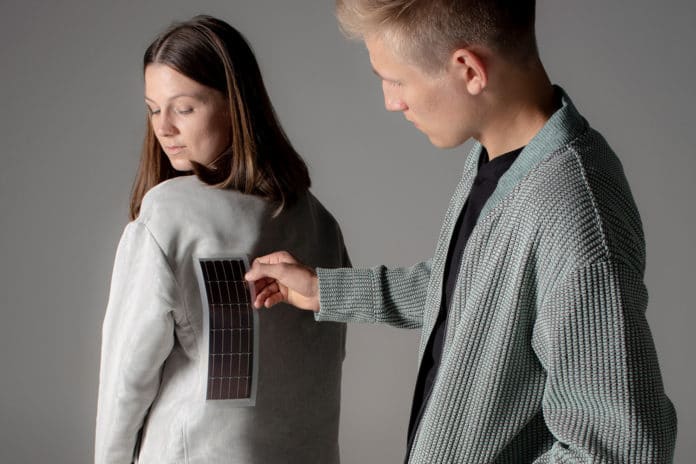Fashion makes a sizeable contribution to climate change, spewing out 4% of all global carbon emissions. But perhaps soon, our clothes could be redesigned to actively reduce our carbon footprint.
Design and physics researchers at Finland’s Aalto University are working to turn this vision into reality. During the three-year Sun-powered Textiles project, they have developed a method of adhering invisible solar cells to textiles that provide an energy source for wearable devices – such as sensors that measure humidity or temperature. This would allow designers to create solar-powered clothing without altering the outfit’s aesthetics. The researchers also took measures to make solar cell-infused textiles recyclable.
Researchers laminated a solar cell component between textiles in a water-tight polyurethane film to make the component machine-washable. They then washed the textiles containing the solar cell component dozens of times at 40 degrees Celsius and measured the output of the solar cells after each round in the washing machine. The result showed five of the eight samples retained their efficiency, and three lost about 20% of their power. None of the cells or textiles were damaged during the process.
“Now that the solar cell laminated between textiles has been proved to be machine-washable, we have to protect the rest of the components. Our idea is that all of the electric components of the smart textile could be in the same container with the solar cell. That would give us a machine-washable electronic device that’s embedded in textiles and never needs to have its battery charged or replaced,” says Janne Halme, university lecturer at the Department of Applied Physics.
The ultrathin solar cell placed under the textile it adheres to has to have a significantly larger surface area than a cell that’s placed on top. A piece of regular fabric eats up roughly 70% of a cell’s capacity – with a more porous fabric, the percentage is smaller.
Key factors in the ability of textiles to let light through them include the material, transparency, crosscut of the fiber, structure of the threads, thickness and weave of the fabric, colors, and finish. Light colors transmit light better than dark colors, but a pitch-black and completely opaque fabric can also work.
For their study, researchers used commercial solar cells comprised of a single crystal and made of silicon. They can detect light that is invisible to the naked eye, which is what most sunlight actually is. The solar panel was designed to be very thin and flexible, covered in a layer of fabric. Of course, hiding the textile eats up some of the solar power but improves its durability, as it’s better protected from the outside world.
The material used was made of only a single fiber and could be recycled as efficiently as possible. Electronic components can be removed from the fabric simply by first applying heat and then tearing them off.
The research team thinks that work clothing is the most potential application for solar cell textiles right now. They are thicker than regular clothes, so the cells have a limited impact on the clothing’s look and feel. “Curtains are another great way to collect solar energy. They could detect the amount of light and adjust themselves accordingly,” says Elina Ilén, project specialist at the Aalto University Department of Design.
“Solar cells hidden under textiles are worth considering as energy sources for electrical equipment that, for one reason or another, has to adhere to textiles, look and feel like a fabric, be machine-washable, use as little power as possible, and whose battery is otherwise either too hard or too expensive to charge or replace,” Halme says.
